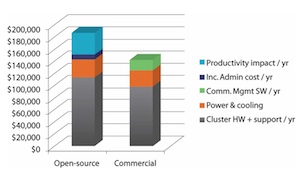Check it Out: Read "The Hidden Costs of Open Source"
Latest News
December 4, 2001
By Anthony J. Lockwood
Dear Desktop Engineering Reader:
 You know from the time you got a free lunch just for attending a seminar on time-shares in Barbados that free is not always free. But have you applied that hard-earned wisdom to work? I have, after burning myself saving money with free applications for my little writing business. Compatibility with the real applications was sketchy, updates were often kind of arcane, and support consisted of earnest but geeky guys on blogs. So I ran up the credit card buying the real McCoys at a time when my income was nil.
You know from the time you got a free lunch just for attending a seminar on time-shares in Barbados that free is not always free. But have you applied that hard-earned wisdom to work? I have, after burning myself saving money with free applications for my little writing business. Compatibility with the real applications was sketchy, updates were often kind of arcane, and support consisted of earnest but geeky guys on blogs. So I ran up the credit card buying the real McCoys at a time when my income was nil.
The cost of free open source software was a disaster for me. Now imagine that you are trying to choose between commercial or open source cluster management software for your small or even large HPC data center. Linux-based open source cluster management software is easy enough to get. You know its positives. But what are the negatives and what can you do to ensure that you make the right decision for your organization? Those questions are what today’s Check It Out white paper from Platform Computing, an IBM company, explore.
“The Hidden Costs of Open Source” does not trash open source cluster management software. It even at one point suggests that a hybrid of open source and commercial could be an attractive approach for you. What it does is examine the administrative and productivity costs of open source, and compares them with a commercial alternative, Platform HPC. The depth of the investigation provides a detailed map of issues to consider so that you can develop a true cost perspective when considering open source or commercial cluster management software.
The framing of this paper is simple: The complexity and costs of deploying, then managing open source clusters can undermine the cost benefits that make them seem like a compelling choice. The execution is straightforward and compelling in its own right. In buzzwords that the MBAs use, this paper looks at: total cost of ownership, risk mitigation, better utilization of resources, cost avoidance, and future proofing.
In addition to the above, the hidden costs of open source range from time spent on administrative tasks to the consequences of informal tech support to cluster performance when your source software is not optimized for your hardware. The words are not used, but it really comes down to what is your company’s core competency? Coding your data center infrastructure or making widgets?
This 12-page white paper seems to be a fine source of good questions, helpful reminders, and “slap your noggin” insights that will help you build your own list of pros and cons as you weigh commercial vs. open source cluster management software. I was around when Linux first appeared, so I know that this paper will not quell the battle over commercial and open source. But it might just be what you need to make perhaps the most important decision in your career. Click the link over there and give it a read.
Thanks, Pal.—Lockwood
Anthony J. Lockwood
Editor at Large, Desktop Engineering
Subscribe to our FREE magazine, FREE email newsletters or both!
Latest News
About the Author
Anthony J. Lockwood is Digital Engineering’s founding editor. He is now retired. Contact him via [email protected].
Follow DE





